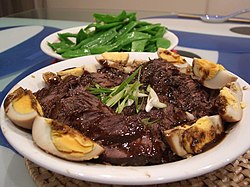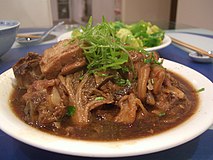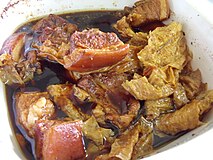
Cantonese or Guangdong cuisine, also known as Yue cuisine is the cuisine of Guangdong province of China, particularly the provincial capital Guangzhou, and the surrounding regions in the Pearl River Delta including Hong Kong and Macau. Strictly speaking, Cantonese cuisine is the cuisine of Guangzhou or of Cantonese speakers, but it often includes the cooking styles of all the speakers of Yue Chinese languages in Guangdong.

Cajun cuisine is a style of cooking developed by the Cajun–Acadians who were deported from Acadia to Louisiana during the 18th century and who incorporated West African, French and Spanish cooking techniques into their original cuisine.

Vietnamese cuisine encompasses the foods and beverages of Vietnam. Meals feature a combination of five fundamental tastes : sweet, salty, bitter, sour, and spicy. The distinctive nature of each dish reflects one or more elements, which are also based around a five-pronged philosophy. Vietnamese recipes use ingredients like lemongrass, ginger, mint, Vietnamese mint, long coriander, Saigon cinnamon, bird's eye chili, lime, and Thai basil leaves. Traditional Vietnamese cooking has often been characterised as using fresh ingredients, not using much dairy or oil, having interesting textures, and making use of herbs and vegetables. The cuisine is also low in sugar and is almost always naturally gluten-free, as many of the dishes are rice-based instead of wheat-based, made with rice noodles, papers and flour. Vietnamese cuisine is strongly influenced not only by the cuisines of neighboring China, Cambodia and Laos, but also by French cuisine due to French colonial rule over the region from 1887 to 1954.
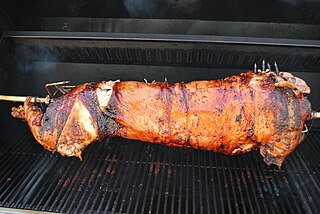
Roasting is a cooking method that uses dry heat where hot air covers the food, cooking it evenly on all sides with temperatures of at least 150 °C (300 °F) from an open flame, oven, or other heat source. Roasting can enhance the flavor through caramelization and Maillard browning on the surface of the food. Roasting uses indirect, diffused heat, and is suitable for slower cooking of meat in a larger, whole piece. Meats and most root and bulb vegetables can be roasted. Any piece of meat, especially red meat, that has been cooked in this fashion is called a roast. Meats and vegetables prepared in this way are described as "roasted", e.g., roasted chicken or roasted squash.
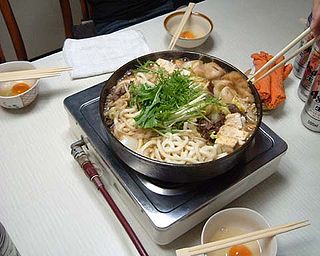
Nabemono, or simply nabe, is a variety of Japanese hot pot dishes, also known as one pot dishes and "things in a pot".
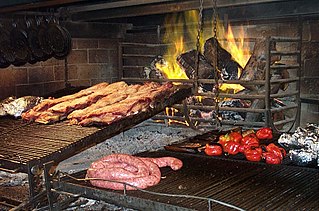
Asado is the technique and the social event of having or attending a barbecue in various South American countries: especially Argentina, Chile, Paraguay, Peru, and Uruguay where it is also a traditional event. An asado usually consists of beef, pork, chicken, chorizo, and morcilla; all of which are cooked using an open fire or a grill, called a parrilla. Usually, red wine and side dishes such as salads accompany the main meats, which are prepared by a designated cook called the asador or parrillero.
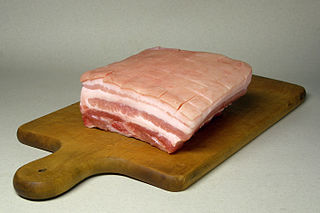
Pork belly or belly pork is a boneless and fatty cut of meat from the belly of a pig. Pork belly is particularly popular in Filipino, Hispanic, Chinese, Danish, Norwegian, Korean, Polish and Thai cuisine.

Daube is a French slow-cooked stew, usually of beef, but other meat is sometimes used. The best-known is the bœuf en daube à la provençale, a provençal stew made with cheaper cuts of beef braised in wine, with vegetables, garlic and herbs, and traditionally cooked in a daubière – a braising pot.

The following outline is provided as an overview of and topical guide to the preparation of food:

Red cooking, also called Chinese stewing, red stewing, red braising, or flavor potting, is a slow braising Chinese cooking technique that imparts a reddish-brown coloration to the prepared food. Red cooking is popular throughout most of northern, eastern, and southeastern China.

Fricassee or fricassée is a stew made with pieces of meat that have been browned in butter then served in a sauce flavored with the cooking stock. Fricassee is usually made with chicken, veal or rabbit, with variations limited only by what ingredients the cook has at hand.

Pot roast is an American beef dish made by slow cooking a usually tough cut of beef in moist heat. Tougher cuts such as chuck steak, bottom round, short ribs and 7-bone roast are preferred for this technique. These cuts are American terms; different terms and butchering styles are used throughout the Anglophone world and beyond. While the toughness of the fibers makes them unsuitable for oven roasting, slow cooking tenderizes the meat as the beef imparts some of its flavor to the water.

A stew is a combination of solid food ingredients that have been cooked in liquid and served in the resultant gravy. Ingredients can include any combination of vegetables and may include meat, especially tougher meats suitable for slow-cooking, such as beef, pork, venison, rabbit, lamb, poultry, sausages, and seafood. While water can be used as the stew-cooking liquid, stock is also common. A small amount of red wine or other alcohol is sometimes added for flavour. Seasonings and flavourings may also be added. Stews are typically cooked at a relatively low temperature, allowing flavours to mingle.
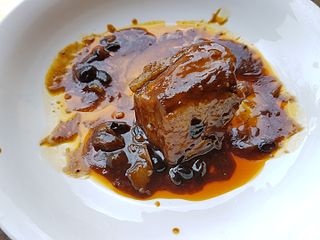
Humbà, also spelled hombà, is a Filipino braised pork dish from Visayas, Philippines. It traditionally uses pork belly slow-cooked until very tender in soy sauce, vinegar, black peppercorns, garlic, bay leaves, and fermented black beans (tausi) sweetened with muscovado sugar. It also commonly includes hard-boiled eggs and banana blossoms.

In cooking and gastronomy, goose is the meat of several species of bird in the family Anatidae, which also includes ducks and swans. The family has a cosmopolitan distribution, and various wild species and domesticated breeds are used culinarily in multiple cuisines. There is evidence as early as 2500 BC of deliberate fattening of domesticated geese in Egypt.
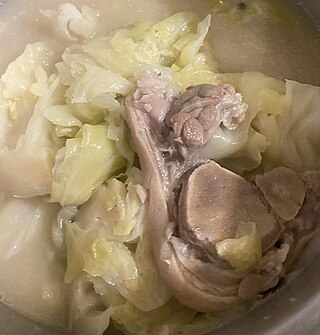
Lauya is a Filipino stew. Its name is derived from the Spanish-Filipino term "la olla", likely referring to the native clay pots in which stews were made in. It is now often associated with the Ilocano stew typically made with pork or beef. The term is sometimes used in Ilonggo cuisine.
